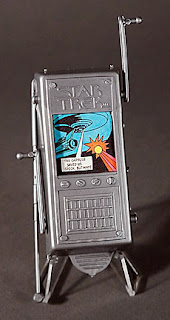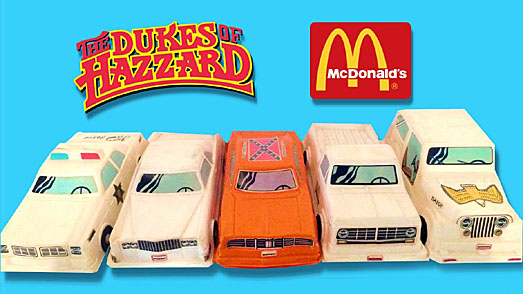 QUESTION: I was going through some boxes in our attic and discovered one filled with those little toys my kids used to get in McDonald’s Happy Meals. Most people, especially mothers, consider these junk. Do they have any value or should I just toss them?
QUESTION: I was going through some boxes in our attic and discovered one filled with those little toys my kids used to get in McDonald’s Happy Meals. Most people, especially mothers, consider these junk. Do they have any value or should I just toss them?
ANSWER: Believe it or not, some of those little toys are actually little treasures, depending on their condition. McDonald's is famous for its Happy Meals, and kids the world over I have been fattened up on weekly doses of them for over 40 years. Since the early 1980s, the main hook has been the toy included with the meal.
Many collectors of McDonald's memorabilia are mostly interested in toys that relate to specific McDonald's characters, but there have also been many tie-ins with established movie, TV and toy lines. Those tie-in items appeal to collectors who are specifically interested in what the Happy Meals promoted.
 The first major tie-in to the action adventure market was with Star Trek. The series returned from TV limbo in the form of a highly promoted film in 1979, and producers planned a huge promotion. This included Star Trek Happy Meals based on the movie. Six different boxes featured activities. One box encouraged kids to fill in the dots to complete a picture of the Enterprise while another offered a chance to decode a message with Mr. Spock, and so on. Toys and premiums included plastic Video Communicators, iron-on transfers of the characters and the Federation symbol, and "Navigational" wrist bracelets.
The first major tie-in to the action adventure market was with Star Trek. The series returned from TV limbo in the form of a highly promoted film in 1979, and producers planned a huge promotion. This included Star Trek Happy Meals based on the movie. Six different boxes featured activities. One box encouraged kids to fill in the dots to complete a picture of the Enterprise while another offered a chance to decode a message with Mr. Spock, and so on. Toys and premiums included plastic Video Communicators, iron-on transfers of the characters and the Federation symbol, and "Navigational" wrist bracelets.

Another heavily merchandised franchise was The Dukes of Hazzard, the campy rural action show that dominated TV in the early 1980s. In the summer of 1982, McDonald’s test marketed a Dukes of Hazzard promotion in St. Louis. The items included plastic cups with pictures of the various characters, and vacuumed plastic meal containers in the shape of the vehicles from the series, including the General Lee car and Daisy's Jeep.
Hot Wheels came to McDonald's in 1983.The cars were the subject of a national promotion, but there were also certain cars distributed only on the East Coast, and some only on the West Coast. Others appeared nationwide. McDonald’s offered 14 Hot Wheels cars in Happy Meals at any given location. There were "Collect All 14" store displays that included these 14 cars. The cars from this promotion individually sell for $10 to $15, but the 14-car display unit commands can sell for between $300 and $400.
E.T. was a huge promotion for McDonald's, thanks to the family-friendly appeal of the movie. Although E.T. appeared in theaters in the early 1980s, the first Happy Meal with an ET theme didn’t go on sale until 1985. It offered two different box designs and a series of four posters depicting scenes from the film.
Hasbro, the toy industry giant, got into Happy Meals with a combined promotion for Transformers and My Little Pony. Transformers, robots that became vehicles and other mechanical devices, were one of the top selling action figure lines of the 1980s. Each original Happy Meal promotion include four different small Transformers. Today, they sell for between $40 and150 each for diehard Transformers collectors and up to $100 if they’re still in their cellophane baggie packs.
 Ghostbusters, the cartoon TV show known as the Real Ghostbusters spun off of the hit movie, became the next big craze for kids in the action/adventure genre. Ghostbusters appeared in McDonald's Happy Meals in 1977 with four different boxes and school supplies based on the Marshmallow Man and Slimer ghosts seen in the film and cartoon series. These included a pencil case, ruler, note pad and eraser, pencil and pencil topper, and pencil sharpener. All are difficult to find and highly collectible.
Ghostbusters, the cartoon TV show known as the Real Ghostbusters spun off of the hit movie, became the next big craze for kids in the action/adventure genre. Ghostbusters appeared in McDonald's Happy Meals in 1977 with four different boxes and school supplies based on the Marshmallow Man and Slimer ghosts seen in the film and cartoon series. These included a pencil case, ruler, note pad and eraser, pencil and pencil topper, and pencil sharpener. All are difficult to find and highly collectible.
Hot Wheels returned in 1989 with more cars available in different regions. There was a 12-ear display that now sells for $300, followed by repeated promotions, shared by Mattel's other titan, Barbie, throughout the 1990s.
Not to be outdone, Matchbox also had a promotion in 1988, featuring a 16-car counter display and cars that now sell for $8 to $10 each.
 The I990s proved to be even mare interesting for action-adventure tie-ins, as several popular super heroes became involved with Happy Meal promotions.
The I990s proved to be even mare interesting for action-adventure tie-ins, as several popular super heroes became involved with Happy Meal promotions.
1991 saw McDonald's teaming with Disney to promote Hook, the retelling of Peter Pan with Robin Williams and Dustin Hoffman. The official Hook Happy Meal boxes, which featured striking artwork, contained four Hook floating bathtub toys.
 A tie-in with the TV cartoon version of Back To The Future caused some controversy. The assortment consisted of four rolling toys, but Doc's time traveling Delorean car had wheels that small children could remove and swallow. McDonald's issued an advisory to parents, urging them to avoid giving the cars to small children. The next big promotion also had its share of problems.
A tie-in with the TV cartoon version of Back To The Future caused some controversy. The assortment consisted of four rolling toys, but Doc's time traveling Delorean car had wheels that small children could remove and swallow. McDonald's issued an advisory to parents, urging them to avoid giving the cars to small children. The next big promotion also had its share of problems.
In 1992, McDonald's was ready to cash in on Batman merchandising and featured a big promotion involving Batman Returns with four vehicle toys, including Catwoman’s car.
 For some reason, Halloween toys are usually big hits. The Ronald and Pals Haunted Halloween McDonald’s Happy Meal set featured a 20-inch display used at McDonald's restaurants in the 1990s. The company ran their 1998 promotion nationally during October. Unfortunately, many store managers trashed most of the displays afterward. The promotion included six toys—I am Hungry, Witch Birdie, Black Cat Grimace, Jack-o-lantern McNugget Buddy, Ghost Ronald, Scarecrow Hamburglar and Ghoul.
For some reason, Halloween toys are usually big hits. The Ronald and Pals Haunted Halloween McDonald’s Happy Meal set featured a 20-inch display used at McDonald's restaurants in the 1990s. The company ran their 1998 promotion nationally during October. Unfortunately, many store managers trashed most of the displays afterward. The promotion included six toys—I am Hungry, Witch Birdie, Black Cat Grimace, Jack-o-lantern McNugget Buddy, Ghost Ronald, Scarecrow Hamburglar and Ghoul.
The McDonald’s Happy Meal for Disney Toy Story2 in 1999 includes pretty much every recognizable toy from the "Toy Story 2" movie. The complete set included an incredible 20 toys, which doesn’t seem possible for the movie.
 Not all McDonald's toys were tiny plastic junk. Some, like It’s Happy Meal Girl Doll from 1997, were big plastic junk, part of a series of Happy Meal baby dolls. Actually, these dolls were surprisingly well made for something produced by a burger chain.
Not all McDonald's toys were tiny plastic junk. Some, like It’s Happy Meal Girl Doll from 1997, were big plastic junk, part of a series of Happy Meal baby dolls. Actually, these dolls were surprisingly well made for something produced by a burger chain.
And while the intention of Happy Meals was to get kids to eat McDonald’s foods and make them happy, those same little toys are making many collectors happy as well.
To read more articles on antiques, please visit the Antiques Articles section of my Web site. And to stay up to the minute on antiques and collectibles, please join the over 30,000 readers by following my free online magazine, #TheAntiquesAlmanac. Learn more about "Advertising of the Past" in the 2023 Spring Edition, online now. And to read daily posts about unique objects from the past and their histories, like the #Antiques and More Collection on Facebook.






































